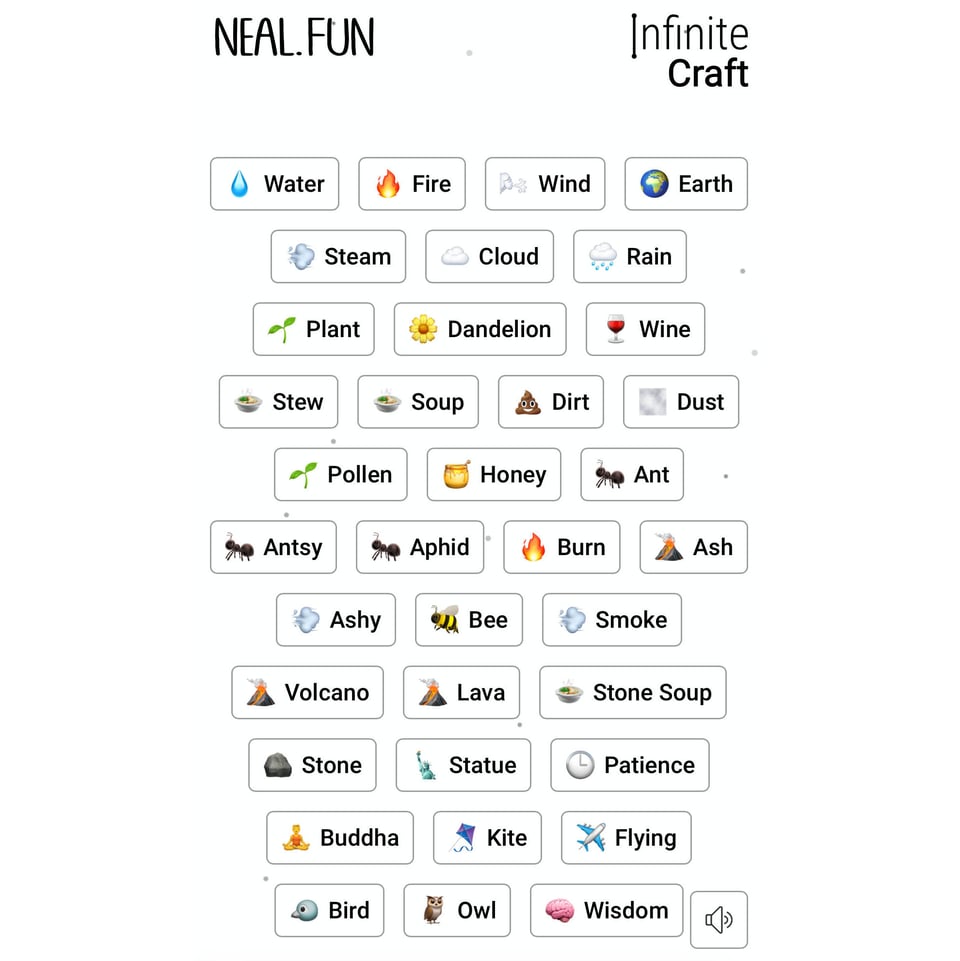Linkfest #18: Infinite Crafting, the "Reverse Sprinkler" problem, and A Gearbox That Will Outlive The Universe
It's time for "the opposite of doomscrolling", people! 🌞
Here's your next Linkfest -- the best reading material I could find while scavenging the vasty beaches of the winedark Internet.
Thanks so much for subscribing! And if you’re enjoying it, hey hey: Spread the word -- forward this email to anyone who you think might enjoy it, anywhere on the planet. There's a pay-what-ya-want signup here; the folks who can afford to contribute help keep it free for everyone else.
To begin ...
1) ⚙️ A gearbox that will outlive the universe
This gearbox -- created by 3D designer Steven Wolfe -- is pretty wild. It has 170 gears, each one connected to the next with a 10:1 ratio; spin a gear ten times and it'll spin the adjacent wheel one time.
When the adjacent wheel has itself spun ten times, it'll spin the next adjacent wheel one time. And so on, and so on, each wheel needing to spin ten times to get the next one to spin once ... until finally, you get the 170th wheel spinning.
So ... how many times would you have to spin the first wheel before you finally got that 170th wheel spinning?
Well, that'd be 10 to the 169th power, which is more revolutions than there are atoms in the observable universe.
Wolfe calculates that he would need to spin the first gear "faster than the speed of light" to complete all those revolutions before the heat-death of the universe; or, as he says ...
In other words, this is basically impossible.
He's put the 3D printer files online, so you too, if you'd like, can print an impossible machine that will outlast the universe!
2) 🏈 Pairing sports with fine art

LJ Rader is a connoisseur of sports and fine art -- and is hilariously adept at connecting the two.
On X/Twitter and Instagram, he runs accounts called "Art But Make It Sports", where he takes pictures from games and pairs them with pieces of fine art with eerily similar compositions.
That one above? It's Jason Kelce hollering excitedly after his brother Travis Kelce scored a touchdown for Kansas City. Rader paired it with "The Feast of Bacchus", a 1654 painting by Philips Koninck.
Rader's ability to do these pairings relies on his unbelievably encyclopedic memory for visual art. Some suspect him of using AI to help find these matches, but he insists it's just pure human recall: He has 10,000 images of art on his phone, and goes to museums all the time.
When the New York Times reporter Scott Cacciola wrote a story about Rader, Rader put his skill to the test, live: Cacciola showed him images from games, and Rader instantly recalled artworks that matched them ...
Amid a series of uncanny comparisons, Mr. Rader needed about 2.7 seconds to match a photo of “The Catch,” Dwight Clark’s touchdown reception for the San Francisco 49ers in the 1981 N.F.C. Championship Game, to “The Intervention of the Sabine Women,” an 18th-century painting by Jacques-Louis David. In the painting, it is not the main subject that resonated with Mr. Rader, but rather a woman in the background who is holding a baby over her head as a battle engulfs her. (She could have been catching a football amid a swarm of defenders.)
You can read the whole Times piece here; that's a gift link, so you don't need a subscription.
3) 🎸 The guitar solo from "Comfortably Numb", on harmonica
I don't really listen to Pink Floyd; I certainly respect the songwriting and their musical chops, but it's not music I kick back to, if you know what I mean.
Maybe what Pink Floyd needed is ... more harmonica? Above, Will Wilde plays his version of David Gilmour's solo from "Comfortably Numb". Gilmour was a soaring and deeply musical soloist, so the original break is remarkable; but this is some next-level playing. Give it a listen ...
4) 🍞 You can get a free sourdough starter that dates to 1847

Carl Griffith was a guy from Oregon whose family originally arrived via the Oregon trail back in the mid-1800s. They made a sourdough starter in 1847, and kept it going through generations until it passed down to Carl himself in the late 20th century.
Carl was famous for giving some of the starter to anyone who asked. He died in 2000, but a group of his friends have kept the starter going and will, to this day, give it away to anyone who asks for it.
From their FAQ:
How can this starter really be the same as it was in 1847?
We make every effort to keep this starter “pure.” Our growers and keepers only have Carl’s starter in their home so we don’t get microorganisms from other starters accidentally mixed in. They use sanitary (but not sterile procedures) to keep it healthy. This is a lot cleaner than Carl’s ancestors could possibly have been in 1847 when they took it on the Oregon Trail migration. Our processes are fully documented on this website.
Could local environmental organisms change the starter? Possibly. Some microbiologists did a study on how stable established strong and healthy starters are and they found that essentially, a strong starter out-competes other organisms in the environment and keeps its characteristics. This is what we have found with our starter. It continues with its characteristics since we have been providing it.
5) 🎨 Art made from e-waste

Over at Hyperallergic, they have a terrific piece about an artist who makes his works entirely from e-waste:
Elias Sime’s large, multipaneled works gleam like aerial views of cities caught in the evening sun or undulate like topographical diagrams of mountains and rivers. On closer inspection, these scenes resolve into mazes of wires, circuit boards, batteries, bulbs, and keys. Currently on view in Eregata እርጋታ at Arnolfini, they are crafted from discarded electronics, many of which find their way to the artist’s home city of Addis Ababa, Ethiopia, after being disposed of around the world. Sime seeks to make visible the vast scale of the waste produced by digital technologies, which, as communications become increasingly fast, are also reaching obsolescence with increasing rapidity.
That artwork above? Here's a close up ...

When you lean in, you can really see the texture!
I love this, because when I was a young kid I used to open up radios and remote controls so I could see the circuit-boards loaded down with resistors, capacitors, and microchips. It always looked like a little city inside there! Steve Jobs used to insist that the boards in Apple's first computers be laid out "beautifully", so they'd impress anyone who looked upon them.
Of course, all that electronic beauty is also toxic as hell. Sime's work does a wonderful job of capturing both parts of that equation.
6) ⌚️ Rotating-squares wall clock

Over at Thingiverse, dr_badger has posted the files so you can 3D-print this very cool wall-clock design.
This is a clock where, instead of having linear hands, the entire clock face rotates. This produces interesting geometrical patterns throughout the day as the two hands intersect at various angles.
I wish they'd included an animated gif of the clock in action, so we could see how the pattern changes!
To find out, I guess I'll have to print one up and assemble it ...
7) 🛠️ Infinite crafting game

Neal Agarwal, an awesome creative coder, released this fascinating game: Infinite Craft.
The concept is simple: You start with four primal elements -- earth, water, fire, and wind -- and you combine any two to make something new. "Earth" and "water" make "plant"; "fire" and "water" make "steam".
The thing is, you can take the new things you've crafted and use them in combos, too. So "plant" and "wind" make "dandelion", or "steam" and "earth" make mud. You just keep on combining stuff to see what you get -- the fun is in the surprises.
Since it's using a language model to produce the combos, the combinations often make sense, semantically. When you combine "steam" with "plant" the model gives you ... "tea". Right?
It's pretty engrossing. I texted it to family members last Saturday and we sat around for an hour, producing ever-weirder combos and texting them back and forth to each other. Above is a screenshot of my game, about ten minutes in. A few minutes later I somehow produced "Shakespeare" -- I can't remember how, alas -- and then had a blast combining Shakespeare with everything.
Give it a try! I find the game-controls are more intuitive on mobile, but it plays fine in a laptop browser too.
8) 🏃 Why women dominate in 240-mile-long ultramarathons

Here’s a fascinating piece about female ultramarathoners, focusing on the runner Courtney Dauwalter.
She’s famous for nearly-unfathomable feats of endurance. Back in 2017, Dauwalter won a 100-mile race in Colorado, completing it in 20 hours and 38 minutes -- despite the fact that for the last 12 miles her vision began clouding with “corneal edema”, a condition where the body can’t get enough fluid up to the eyes; she was “effectively 90% blind” for the final 12 miles. A few years ago Dauwalter completed three 100-mile marathons in a single summer. In 2017, she won the Moab 240, which is 238 miles long in burning hot Utah; she beat all the women and was ten hours faster than the fastest man.
Now, this latter fact, about beating the guy? In shorter marathons, women essentially never beat men. When you're running 26 miles, men’s higher-on-average proportion of fast-twitch muscle and better peak speed give them a strong edge.
Ah, but if you're running more than 26 miles? Here's where it gets fascinating!
In professional marathons, women are, on average, 11.1% slower than men. Greater muscle mass and a higher V02 range mean that, barring a long shot, women will always finish behind men over this distance when ability levels are considered. Yet at 50 miles, there is only a 3.7% difference; at 100 miles, just 0.3% separates men and women.
"It seems 195 miles is the magic number where women become faster than men," says Jovana Subic, head of running research at Run Repeat, a website that analysis running shoes and the sport in general and which released a State of Ultra Running Report in 2020.
Statistics above this distance show that women are, on average, 0.6% faster.
Some caveats are in order. First off, the population of ultramarathoners is so small, and the events so relatively infrequent, that drawing firm conclusions about male/female performance on massive runs is tricky. The trend seems real, but as scientists are fond of saying, more research is needed.
It's an absorbing story, though, and Dauwalter is a really inspiring figure. Go read the whole thing!
9) 🧠 Non-AI image generator

The artist Pablo Declan has set up "Prompt-Brush", an online image-generating service.
The very first non-A.I. generative art model.
Send me a message with your prompt and I will generate a drawing with black ink on paper and send it back to you.
Examples of his drawings above!
A few years ago I thought of a similar concept, except as a search engine. You'd type your query into the search engine and it would send it to me. I'd research it and send it back to you, along with a confidence statement of how well I think I answered it. If the query seemed unanswerable or a matter of opinion I'd just send it back with a yeah, nope. The search engine would only accept one request at a time; if I were working on someone's query the page would have a "sorry, off answering someone else's question, try back later" message.
Maybe I'll do it ...
10) 🐞 The glitch that made Grand Theft Auto fun

Grand Theft Auto is a massive video-game series now, almost 30 years old. But apparently the game almost never launched -- because the initial design was too boring.
The very first GTA that came out in 1997 was a top-down old-school 2D arcade game, in which you played as a bad guy doing missions, while trying to avoid the police. (Internally, they were calling the game Race'n'Chase.) The designers were struggling with it, though. The missions were kind of repetitive, so even the designers themselves got bored playing it. At this rate they'd never release the game at all.
But a stray programming glitch saved the day. As Gary Penn, one of GTA's designers, tells it in this blog post:
"... one day, I think it was a bug, the police suddenly became mental and aggressive. It was because they were trying to drive through you. Their route finding was screwed I think and that was an awesome moment because suddenly the real drama where, ‘Oh my God, the police are psycho — they’re trying to ram me off the road.’”
The bug wasn’t intended, of course, but it was fun — and it was enough for DMA Design to rethink Race’n’Chase entirely. As GameFAQs reported, “This glitch turned out to be the shot in the arm that the game needed. Suddenly, every chase was a life-or-death struggle against a psychotic army of suicidal police cruisers who would stop at nothing to turn your car into a twisted heap of burning scrap metal by any means possible. The playtesters started ignoring the missions and the dev team discovered that messing around in the open world was often more fun than following the game’s story.”
Love it! I've done jusssst enough game design and programming to know that these sorts of happy accidents are surprisingly common in the field. A lot of game design is tweaking: You set up the general gist of the game, then slightly alter things -- the force of gravity, the speed you move, how often opponents spawn -- and play and play and play it, until one day it just feels perfectly balanced.
There's a lot of room for luck and happy accidents ...
11) 🎶 ChatGPT, creativity, and Coleridge's "Aeolian Harp"

Where does creativity come from? ChatGPT and generative AI have put fresh life into that age-old question, now that people are using LLMs and image-generators to make stuff for them. Does creativity require human agency, or can it be something that emerges from a computer process? Can it be industrial, mechanical?
An aeolian harp is a stringed box that you set in a window -- and when wind blows through, it produces melodies. They were all over the damn place in the 19th century, apparently, so popular that they weren't vanquished until the radio came along.
The aeolian harp was, in a sense, an algorithm: You programmed it by picking the specific notes that the strings would play. But the action of the wind imparted a lot of unpredictability and randomness. As Schwartz notes, sometimes the wind would blow strongly and the harp wouldn't make a sound. Then, when things seemed still, a few strings would spring to life.
Basically, the creative output of the system -- as it were -- emerged from a complex interaction with the outside world.
When Coleridge pondered his own aeolian harp, he decided this was a pretty good model for how human creativity worked:
That summer evening in Clevedon, Coleridge was overcome by this Aeolian mystery. As the breeze blew and the harp issued forth its sounds, the groom-to-be meditated on how the passive harp was nevertheless capable of producing music. Coleridge then began to wonder whether he was also just an instrument, like the harp, and that his verses were not composed through free will or human drive but just the product of sensory inputs interacting in some way with his brain. The idea struck Coleridge powerfully, prompting him to write a poem called “The Eolian Harp,” which is structured like the galaxy-brain meme, escalating in philosophical profundity with each stanza until it reaches its crescendo:
And what if all of animated nature
Be but organic Harps diversely framed,
That tremble into thought, as o’er them sweeps
Plastic and vast, one intellectual breeze,
At once the Soul of each, and God of all?In other words, what if we’re all just self-playing harps?
Coleridge's metaphor went viral; Romantic writers all seized on it and talked about it. It resonated with all sorts of concepts that were in the air: Philosophic ideas about the clockwork nature of humans, or the wild boom in industrial machinery.
Schwartz never brings it back to ChatGPT, alas. But it's useful mental fodder for pondering where creativity comes from, and where it's going. Worth a read!
(Bonus: That image above? It's from the "Aeolian Harp Project", an academic analysis (by Lisa Spalding) of the sounds produced by the device, at Worcester Polytechnic University. And Spalding's analysis is part of a whole cool group of 21 "Musical Machines" projects. I'm gonna check them all out ...)
12) 🎁 A final, sudden-death round of reading material
They thought this language was dead. 🎁 Solar churches. 🎁 What it's like to attempt Taylor Swift's treadmill tour-prep regimen. 🎁 Trapping "phonons". 🎁 A chess set that you burn. 🎁 "Not even death could put a stop to his photobombing of Keats’s life." 🎁 The history of comic sans. 🎁 Janos Megyik's photograms. 🎁 A study of lost wallets finds that most people are pretty honest. 🎁 Steamboat Willie in MS-DOS. 🎁 "Is it insider trading if I bought Boeing puts while I am inside the wrecked airplane?" 🎁 Whiskey-scented candles. 🎁 "Using prompt engineering to better communicate with people." 🎁 BoardZilla, a tool for making online board games. 🎁 The "reverse sprinkler problem". 🎁 The dropshippers of South Africa. 🎁 Massive, transparent horn-shaped stereo speakers. 🎁 The secret reason The Beatles made such a splash on The Ed Sullivan Show. 🎁 The "Women's Petition Against Coffee" of 1674. 🎁 The world's fastest desk. 🎁 The tyranny of "the rocket equation". 🎁 Hunt The Wumpus as a clickable HTML game. 🎁 "Penrose", a computer language that turns textual descriptions of data and geometry into interactive visuals. 🎁 I'm intrigued by these open-source "Frame" AI glasses. 🎁 Add coffee stains to virtual LaTeX documents. 🎁 "Frankenstein batteries". 🎁 Mixtape Garden.